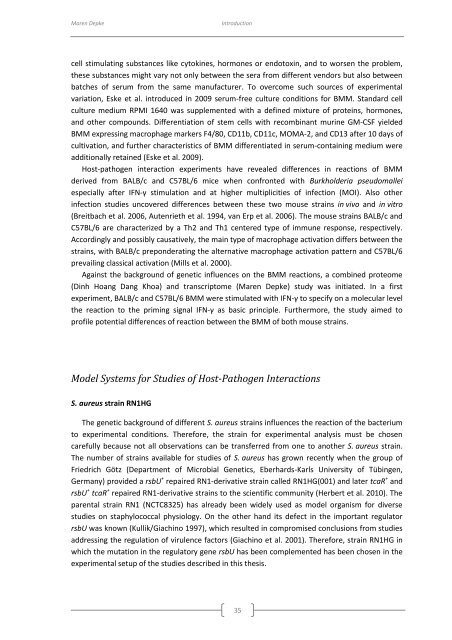genomewide characterization of host-pathogen interactions by ...
genomewide characterization of host-pathogen interactions by ...
genomewide characterization of host-pathogen interactions by ...
You also want an ePaper? Increase the reach of your titles
YUMPU automatically turns print PDFs into web optimized ePapers that Google loves.
Maren Depke<br />
Introduction<br />
cell stimulating substances like cytokines, hormones or endotoxin, and to worsen the problem,<br />
these substances might vary not only between the sera from different vendors but also between<br />
batches <strong>of</strong> serum from the same manufacturer. To overcome such sources <strong>of</strong> experimental<br />
variation, Eske et al. introduced in 2009 serum-free culture conditions for BMM. Standard cell<br />
culture medium RPMI 1640 was supplemented with a defined mixture <strong>of</strong> proteins, hormones,<br />
and other compounds. Differentiation <strong>of</strong> stem cells with recombinant murine GM-CSF yielded<br />
BMM expressing macrophage markers F4/80, CD11b, CD11c, MOMA-2, and CD13 after 10 days <strong>of</strong><br />
cultivation, and further characteristics <strong>of</strong> BMM differentiated in serum-containing medium were<br />
additionally retained (Eske et al. 2009).<br />
Host-<strong>pathogen</strong> interaction experiments have revealed differences in reactions <strong>of</strong> BMM<br />
derived from BALB/c and C57BL/6 mice when confronted with Burkholderia pseudomallei<br />
especially after IFN-γ stimulation and at higher multiplicities <strong>of</strong> infection (MOI). Also other<br />
infection studies uncovered differences between these two mouse strains in vivo and in vitro<br />
(Breitbach et al. 2006, Autenrieth et al. 1994, van Erp et al. 2006). The mouse strains BALB/c and<br />
C57BL/6 are characterized <strong>by</strong> a Th2 and Th1 centered type <strong>of</strong> immune response, respectively.<br />
Accordingly and possibly causatively, the main type <strong>of</strong> macrophage activation differs between the<br />
strains, with BALB/c preponderating the alternative macrophage activation pattern and C57BL/6<br />
prevailing classical activation (Mills et al. 2000).<br />
Against the background <strong>of</strong> genetic influences on the BMM reactions, a combined proteome<br />
(Dinh Hoang Dang Khoa) and transcriptome (Maren Depke) study was initiated. In a first<br />
experiment, BALB/c and C57BL/6 BMM were stimulated with IFN-γ to specify on a molecular level<br />
the reaction to the priming signal IFN-γ as basic principle. Furthermore, the study aimed to<br />
pr<strong>of</strong>ile potential differences <strong>of</strong> reaction between the BMM <strong>of</strong> both mouse strains.<br />
Model Systems for Studies <strong>of</strong> Host-Pathogen Interactions<br />
S. aureus strain RN1HG<br />
The genetic background <strong>of</strong> different S. aureus strains influences the reaction <strong>of</strong> the bacterium<br />
to experimental conditions. Therefore, the strain for experimental analysis must be chosen<br />
carefully because not all observations can be transferred from one to another S. aureus strain.<br />
The number <strong>of</strong> strains available for studies <strong>of</strong> S. aureus has grown recently when the group <strong>of</strong><br />
Friedrich Götz (Department <strong>of</strong> Microbial Genetics, Eberhards-Karls University <strong>of</strong> Tübingen,<br />
Germany) provided a rsbU + repaired RN1-derivative strain called RN1HG(001) and later tcaR + and<br />
rsbU + tcaR + repaired RN1-derivative strains to the scientific community (Herbert et al. 2010). The<br />
parental strain RN1 (NCTC8325) has already been widely used as model organism for diverse<br />
studies on staphylococcal physiology. On the other hand its defect in the important regulator<br />
rsbU was known (Kullik/Giachino 1997), which resulted in compromised conclusions from studies<br />
addressing the regulation <strong>of</strong> virulence factors (Giachino et al. 2001). Therefore, strain RN1HG in<br />
which the mutation in the regulatory gene rsbU has been complemented has been chosen in the<br />
experimental setup <strong>of</strong> the studies described in this thesis.<br />
35

















